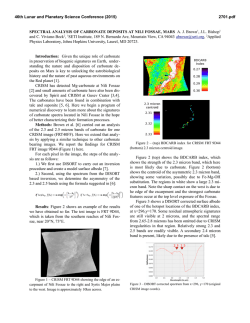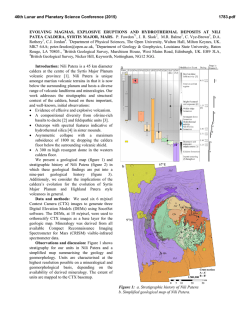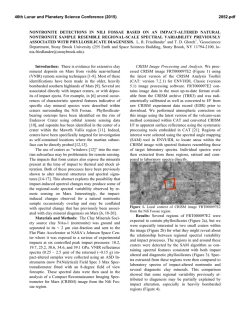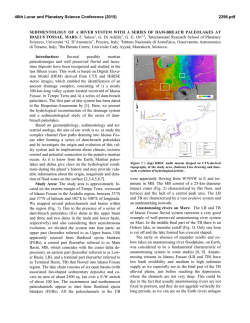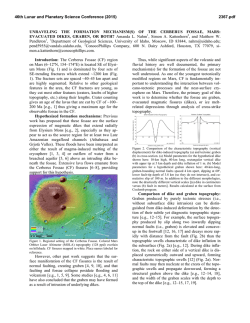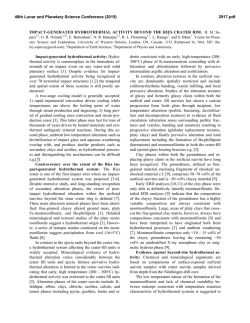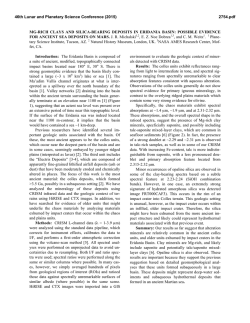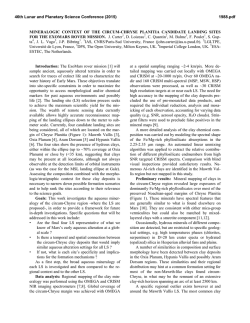
EARLY HYDROTHERMAL ENVIRONMENTS ON MARS
46th Lunar and Planetary Science Conference (2015) 2756.pdf EARLY HYDROTHERMAL ENVIRONMENTS ON MARS: TYRRHENA TERRA. C. E. Viviano-Beck, Johns Hopkins University Applied Physics Laboratory, Laurel, MD <[email protected]>. Introduction: The Nili Fossae region of Mars has some of the most diverse mineralogy detected on the planet to date, including compositionally varying phyllosilicates exposed in outcrops across the entire region. The identification of olivine, serpentine, and magnesium carbonate in the easternmost portions of the Nili Fossae region of Mars has been interpreted as evidence for hydrothermal alteration of an olivine-rich protolith. Studies indicate that Fe/Mg phyllosilicates associated with these carbonate-bearing units have a spectral component consistent with talc, suggesting the carbonation of serpentine. In the westernmost portions of the Nili Fossae region, Fe/Mg phyllosilicates display varying degrees of a chlorite signature that correlates with depth of excavation, consistent with chloritization through burial diagenesis. Here we analyze CRISM spectral data for the presence of carbonate, olivine, serpentine, chlorite, and talc in the greater Tyrrhena Terra region (Fig. 1), where studies indicate the same assemblages may be present. Newly-derived spectral parameters diagnostic of specific phyllosilicate minerals allow for more complete regional mapping of hydrothermal and diagenetic mineral assemblages. The mapping of these phases can be used to determine whether the potential carbonation reaction was a widespread phenomenon, thereby constraining the significance of this process as a CO2 sink in the ancient Martian carbon cycle. lite/muscovite, analcime, Mg-carbonate, and serpentine [1-4]. Some of the mineral assemblages reported represent products of aqueous alteration at elevated temperatures [5]. For example, prehnite, which forms only under specific temperature conditions (T = 200400°C), provides clear evidence for subsurface, hydrothermal/metamorphic alteration (sub-greenschist facies [6]). Other assemblages indicate low-grade metamorphism or hydrothermal circulation of fluids in basalt (prehnite-chlorite-silica and analcime-silica-Fe/Mgsmectite-chlorite), transformation of trioctahedral smectites to chlorites and dioctahedral smectites to illites during diagenesis (chlorite-illite(muscovite)) [5], and low-grade metamorphism or hydrothermal circulation of fluids in ultramafic rocks (serpentine-possible talc-carbonate) [7-9]. Serpentine-bearing rocks: In the Nili Fossae region, the distribution of Mg-bearing carbonates [3], is associated with underlying Mg-phyllosilicates and has been hypothesized to be a weathering product of either the olivine or serpentine in this region [2,4,7]. Impact or volcanic heating of the olivine-bearing material may have led to hydrothermal alteration along the contact with the underlying water-bearing Mg-phyllosilicate unit [3]. Alternatively, the phyllosilicate formed at the Figure 1. Context image of preliminary study site. Box A: CRISM targeted coverage in Libya Montes. Alteration minerals and metamorphic facies: Regional surveys of the terrains in Tyrrhena Terra [1], and west of the Isidis basin in the region surrounding the Nili Fossae [2], reveal a prevalence and wide distribution of alteration phases, including Fe/Mgphyllosilicates, chlorite/prehnite, hydrated silica, il- Figure 2. Schematic outlining alternative hypothesis for Nili Fossae carbonate + serpentine formation. 46th Lunar and Planetary Science Conference (2015) same time as the overlying carbonate-bearing unit by a single hydrothermal event [7] as supported by the spectral identification of a talc component [8] (Fig. 2). The stratigraphic relation of the phyllosilicate and carbonate-bearing units are simply the result of different temperatures regimes within the zone of hydrothermal alteration [7]. Local investigation – Libya Montes: A total of 59 CRISM targeted observations were analyzed in a region on the southern edge of the Isidis Basin rim (Libya Montes) (Fig. 1a). Previous investigations [11] identified a variety of Fe/Mg-smectite chemistries, as well as carbonate and Al-smectite phases. Representative Fe/Mg-phyllosilicate spectra from each CRISM observation are presented in Figure 3, where a comparison of spectral band depths can be used to visually distinguish different Fe/Mg-phyllosilicate species (e.g., talc, smectite, chlorite). Due to limited space, the distribution map of these phases with estimates on areal extent of these phases will be fully presented during the formal presentation of this abstract, but are conveyed in Fig 1a. The red circle represents the region where olivine-carbonate-talc assemblages are identified, whereas the green circle represents the regions where LCP-prehnite-chlorite assemblages are identified. Similarly to the Nili Fossae region, the prehnite/chlorite assemblages lie further (circumferentially) from the center of Isidis than the carbonate/talc assemblages, providing further evidence for the interpretation of the olivine-rich unit to be ejecta from the Isidis impact. 2756.pdf Implications for CO2 sequestration: Based on CRISM targeted coverage in the Nili Fosse region, the serpentization and carbonation reactions appear throughout a ~160,000 km2 area in Nili Fossae. Assuming a uniformly thick (10 m) magnesite-bearing layer where magnesite or talc-related phyllosilicate is present, with an abundance of 80% magnesite, this would be equivalent to ~6,000 Pa (~0.06 atm) of CO2 locked in the rock (~10x the current Martian atmospheric pressure) [8]. While detailed mapping in Libya Montes is required to better constrain this value, an estimated additional ~100,000 km2 of the olivinecarbonate-talc assemblages in Libya Montes would provide an additional sequestered ~0.04 atm (or a total of ~0.1 atm of CO2 between Nili Fossae and Libya Montes). Buried carbonates (e.g. underlying Syrtis Major lava flows) surrounding the Isidis impact basin likely provided ample opportunity for CO2 sequestration on early Mars. References: [1] Fraeman et al., (2009) LPSC, #2320. [2] Ehlmann et al., (2009), JGR, 114. [3] Ehlmann et al., (2008) Science, 322, 1828-1831. [4] Ehlmann et al., (2010) GRL, 37. [5] Ehlmann et al., (2011) Clays & Clay Min., 59, 359-377. [6] Schiffman and Day, (1999), in Low Grade Metamorphism, 108142. [7] Brown et al., (2010) EPSL, 297, 174-182. [8] Viviano et al., (2013) JGR, 118, 1858-1872. [9] McSween et al., (2014) MAPS, in press. [10] Clark et al., (2007), USGS Data, 231. [11] Bishop et al., (2013) JGR, 118, 487-513. Figure 3. Spectral results from Fe/Mg-phyllosilicates. (left) Comparison of continuum-removed laboratory spectra [10]. (right) Fe/Mg-phyllosilicates from preliminary study region in Tyrrhena Terra. Bubble size is proportional to band depth at 2355 nm (BD2355). Spectra identified as prehnite/chlorite in red. Spectra with (BD2450<0, BD2390>0, BD2355>0.003) shown in blue (talc). Small bubbles near origin are likely more consistent with smectite. Points with (BD2450>0, BD2390<0) may be consistent with addition of serpentine (see laboratory spectra).
© Copyright 2026
